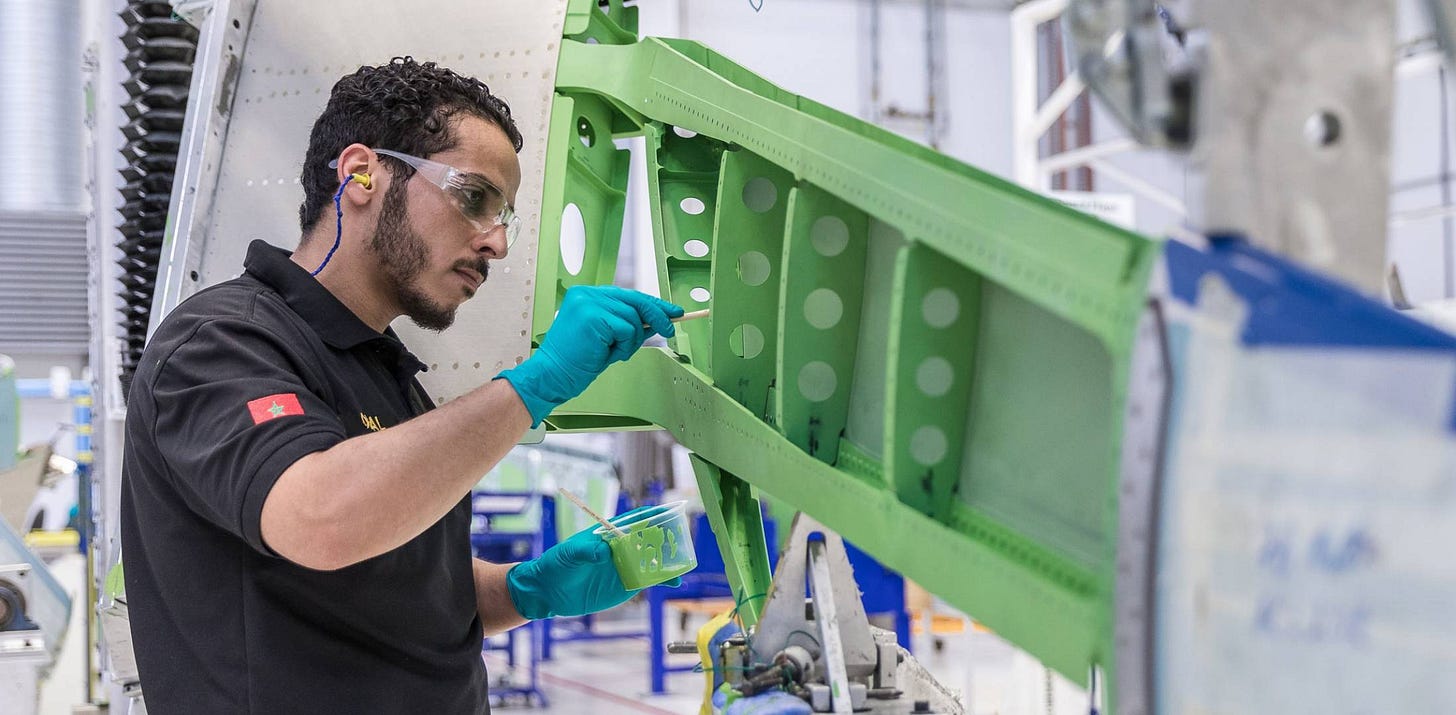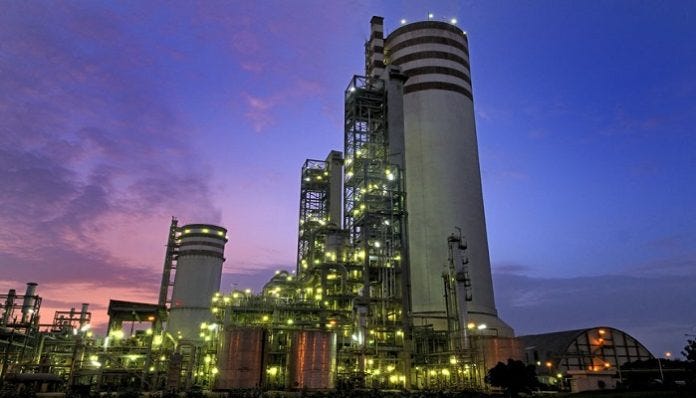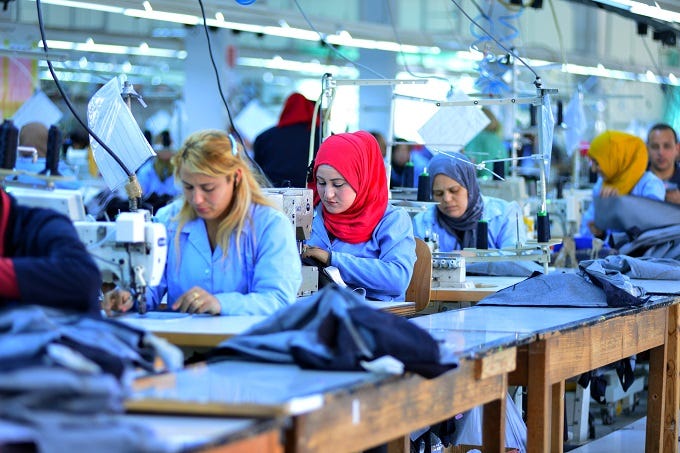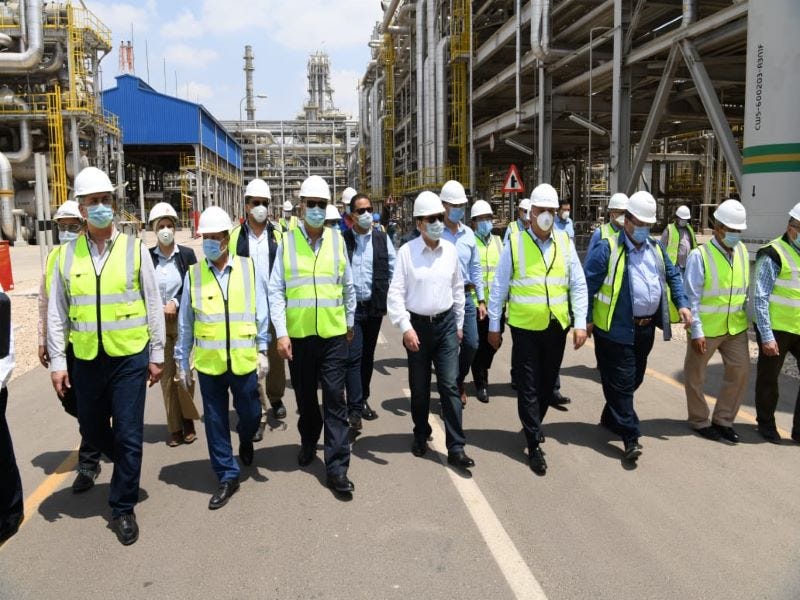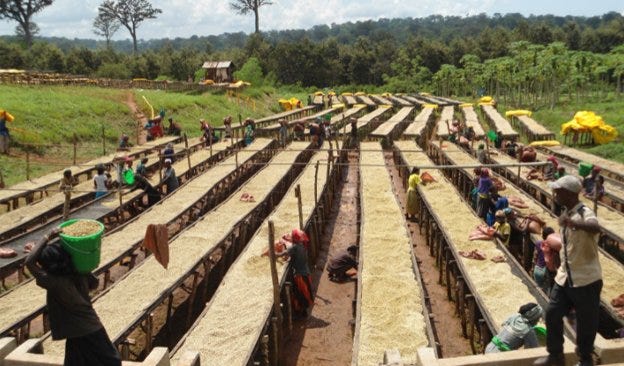Manufacturing in Africa
Meet the 14 African countries that each have billions of dollars of manufactured exports that they sell to the world
In 2021, exports worth $22.45T were recorded globally, with a subsequent growth of 2.6% the next year, reaching 25T trillion. Of these exports, 70% ($17.5T) consisted of manufactured goods. As mentioned before, 85% of the world’s manufactured goods come from three manufacturing hubs: The East Asia & Pacific region, North America, and Europe. The rest of the world’s goods contribute to 15% of trade. You can read more below in a previous article I wrote:
Who Dominates Global Trade?
Contrary to what many Americans may think, America no longer dominates global trade. China is #1, America is #2 in global trade, and Germany is a distant third. However, I put every European Union nation in orange. Since we are talking about global trade, it would make more sense to think of nations in trade blocs. If we reexamine our global trade stats,…
To achieve industrialization, countries must add value to raw materials through processes like transforming iron into steel, cotton into clothes, or refining crude oil into gasoline. African countries, despite wars & corruption, were initially industrializing, fueled by state sponsored investment. Many African countries took advantage of the 1960s to 1980 commodity boom, tin oil, cocoa, and other commodities rose during that time. However, the landscape shifted when demand for commodities faltered amidst the recessions that gripped the world’s biggest commodity buyers at the time: the industrialized nations in North America, Western Europe & Japan.
In a bid to rein in on inflation caused by the energy crisis-price hikes of the Organization of Petroleum Exporting Countries (OPEC) 1973s oil embargo and the drop in oil production caused by 1979 Iranian Revolution, central banks of industrialized economies tamed inflation by raising interest rates to curb demand. UK’s central bank interest rates hit 14% in 1980! Japan hit 8% and in America, interest rates hit 17%! Much higher than the fed funds rate in 2023: 5%. As a result, UK entered a recession (1980-1981), West Germany (1981-1982), America (1981-1982), Italy and Japan as well. This series of economic setbacks led to a decline in global trade during 1981 and 1982. Consequently, the demand for commodities dwindled while the suppliers increased production, resulting in an over supply that precipitated in a sharp drop of global commodity prices.
When commodity prices slumped, African nations that depend on exporting commodities to fuel their growth and purchase food, fuel, medicine, and equipment from abroad went nearly bankrupt. They ran out of foreign currency to prop of the value of their currency, leading to currency devaluations and massive inflation. The African nations took IMF loans to save their economy, but unfortunately IMF loans came with painful conditions attached. Austerity measures such as curtailing government spending, reducing fuel subsidies, cutting business subsidies, and imposing taxes on the population were imposed so the African nations could pay back the loan. Post 1980, much of Africa experienced capital flight and their manufacturing sectors declined. Serendipitously, Chairman Mao in China died, and Deng Xiaoping opened up his economy for foreign investment. As North American, European, and Japanese investment left Africa, they found a new home of growth in China.

But now manufacturing in Africa is making a slight comeback. In pursuit of identifying countries with significant manufacturing capabilities, I focused on those exporting at least $1 billion of a single good (0.0055% of the manufactured goods market). Unfortunately, most sub-Saharan African countries don’t export a single manufactured good that’s at least 1B dollars. 39 nations: Ghana, Libya, Mauritania, Cape Verde, Gambia, Senegal, Guinea, Burkina Faso, Benin, Niger, Chad, Central African Republic, Sudan, South Sudan, Gabon, Cameroon, Equatorial Guinea, Sao Tome & Principe, Benin, Togo, Liberia, Sierra Leone, Guinea-Bissau, Rwanda, Burundi, Tanzania, Malawi, Mozambique, Madagascar, Uganda, Angola, Botswana, Namibia, Somalia, Djibouti, Eswatini, Mauritius, Lesotho and Eritrea are basically entirely raw material exporters that don’t manufacture a single export that’s over $1B.
Fortunately, there are 14 African countries that do export over a billion dollars of a good. Those nations are Morocco, Egypt, Tunisia, Algeria, South Africa, Ivory Coast, both Congos, Zambia, Nigeria, Zimbabwe, Seychelles, Kenya, and Ethiopia.
However, it is essential to recognize that exporting industrialized goods does not necessarily guarantee wealth and high living standards. Botswana, Namibia, and Gabon are upper middle income countries like Indonesia, Argentina or Brazil but don’t export a single manufactured good over one billion dollars. Conversely, the Democratic Republic of Congo is among the world’s poorest nations on yet exports $9B of refined copper to mainly China. Generally, achieving industrialization requires producing multiple industrialized goods worth over a billion dollars, akin to South Africa's approach.
So what are those exports? According to MIT’s Observatory of economic complexity, out of the thousands of categories of goods, only 17 categories fall under the classification of industrialized exports that a few African countries export at a value in billions of dollars.
Aircraft Component Manufacturing: Morocco
Morocco also has a fast growing, talented aerospace workforce. Morocco set up a “Midparc aeronautical zone” in Casablanca, and its free trade zone worked amazingly. Moroccans assemble aerospace parts for Boeing. fuselages for European Airbus, wing components and engines for Canadian Bombardier, Canadian Gal Aerospace, Swiss Pilatus Aircraft Chinese Comac, Brazilian Embraer, and the Russian Sukhoi. Morocco’s aerospace sector is competitive since the average Moroccan aerospace worker makes 39,530 Moroccan Dirham per year ($3926 or roughly $327 per month). This makes Morocco have a cheaper labor force for Western investment than other cheap assembly nations like Tunisia ($338 per month), Turkey ($430 per month), and South Africa ($1280 per month).
Collins aerospace, Safran, and Spirit Aerosystems are also adding Morocco to its supply chain. As of now, Morocco has 140 aerospace companies that manufacture finished aircrafts, provide maintenance, and build aerospace infrastructure.
Intermediate metals Manufacturing: Zimbabwe, Zambia, Democratic Republic of Congo, and Congo-Brazzaville
Nickel Mattes are an intermediate product used in the metallurgical processes with nickel content. They are used in the production of nickel based alloys. Zimbabwe refines raw nickel in the Shangani Mine and in the Trojan Nickel mine. One of the biggest Nickel manufacturing companies in Zimbabwe is the Bindura Nickel Corporation which is owned by Asa Resources Group, a mining company based out of Johannesburg, South Africa & London, UK. It is the first African owned and African managed business to be listed in the Resource sector of the London Stock Exchange’s Alternative Investment Market. The firm was founded in 1987.
Zimbabwe has now banned all nickel exports and is following the Indonesian manufacturing strategy - resource downstreaming. By banning nickel exports, companies will have to invest in Zimbabwe if they want to export nickel based products (like electric vehicles or electric batteries). The question is, will this strategy work in Zimbabwe like it worked in Indonesia? Indonesia has the world’s largest reserves (21M metric tons) meanwhile Zimbabwe doesn’t even climb to the 9th spot, which is America at 0.37M metric tons. Will Asian and Western companies want to invest in Zimbabwe?
Also, Democratic Republic of Congo (DRC), Congo-Brazzaville, and Zambia are major exporters of refined copper. The US government has bipartisan support for a national strategy to secure supply chains of critical minerals from China, and one of those minerals is copper from the DRC. The DRC has recently become the 2nd largest producer of copper, losing only to Chile, and finally beating Peru. Also, Canada’s First Quantum Minerals Ltd, China’s CMOC Group, and India’s Vedanta Resources Ltd are among the biggest investors in copper output in Zambia.
Chemical & Nitrous Fertilizer
The North African nations of Morocco, Algeria, and Egypt sell billions of dollars in fertilizer, which is needed to improve soil fertility and increase plant growth for farming. Fertilizer plays a crucial role in modern farming practices, helping farmers meet the food demands of a growing population and ensuring sustainable agricultural production. Without adequate fertilization, soils may become depleted of nutrients, leading to reduced crop productivity and overall agricultural output.
Clothes & Textiles:
Clothes was the first good that the British started mass manufacturing in the 18th century. Nowadays, Egypt, Tunisia, and Morocco are now selling billions of clothes to Europe, making jeans, shirts, and etc.
Car & Delivery Truck Manufacturing
The African titans that make cars are South Africa and Morocco.
Just like how American car companies use Mexico and China for low cost assembly manufacturing, Europe & Japan compete by using Turkey, China, Vietnam, South Africa and Morocco.
Now Nissan, BMW and Volkswagen are trying to build electric cars in South Africa, provided that South Africa’s state owned, Eskom can provide consistent electricity. Volkswagen is now trying to make electric vehicles in Rwanda now as well.
South Africa also exports billions to the world in chemical products and is also the 11th largest centrifuge exporter on earth.
Refined Oil: Algeria & Egypt
In terms of transforming oil into kerosene, gasoline, jet fuel, motor fuel, only Egypt and Algeria so far have built refineries that currently export over a billion of refined oil. Nigeria, under billionaire tycoon Dangote, just built its largest oil refinery, which is now the largest refinery on the continent. It is expected that Nigeria will join Egypt and Algeria on this list soon.
Beverage Manufacturing: Tea & Coffee
Ethiopia makes billions selling coffee and Kenya makes in the billions tea.
Some billion dollar manufactured products in Africa I didn’t mention: Seychelles and boat building, Nigeria building ships, Egypt, Tunisia, and Morocco making insulated wire, and Ivory Coast making a billion dollars in selling cocoa paste.
So what does this mean? We do have some billion dollar manufacturing players in Africa that compete on the global market, but most of them are in North Africa or South Africa. We still need African countries that can export billions in medical instruments, LCDs, seats, sporting equipment, glass mirrors, shoes, explosive ammunition, phones, and beauty products. Most of Western and East Asian manufacturing expansion is going into low-cost Asian countries (Vietnam, Bangladesh, Indonesia, etc.) to diversify their supply chains from China. Will Africa pick up some investment? Luckily we see promising signs especially in German cars in Ghana, satellites in Kenya, Zimbabwe, and Uganda, and electronics in Egypt.
Sources are linked!
Export Data comes from:
https://oec.world/






